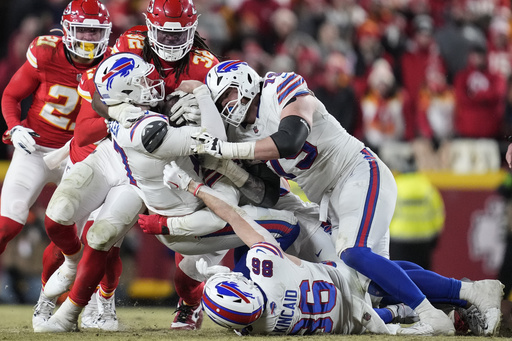The NFL is set to collaborate with its Competition Committee to explore the implementation of technology for virtual line-to-gain measurements in the upcoming season, while traditional officials will continue to spot the ball on the field.
Currently, there is no technological solution on the table for determining forward progress. This topic gained attention after a controversial moment in which Josh Allen was deemed to have come up short on a fourth-and-1 sneak during the critical minutes of Buffalo’s 32-29 defeat to Kansas City in the AFC championship game.
In preseason, the league evaluated Sony’s Hawk-Eye tracking services, which measure the line-to-gain virtually. This advanced system alerts officials immediately if a first down is achieved after the ball has been manually spotted.
The primary function of this technology is to serve as a replacement for the traditional chain measurement system. For years, the NFL has relied on two signature orange sticks connected by a chain—commonly referred to as the chain gang—to mark first downs. However, this new approach will function as a backup option.
Kennedy Fields, an NFL executive, clarified that the technology does not replace the human element when it comes to assessing where a player’s forward progress ceases. “There will always be a human official spotting the ball,” she noted. “Only after the ball is placed will the line-to-gain technology conduct its measurement. There seems to be some misunderstanding about the capabilities of this technology, but the human aspect is essential because of the forward progress matter.”
During the regular season, an average of 12 measurements were taken weekly. The introduction of this new technology could cut down the measuring time from 75 seconds to just 35 seconds.
NFL footballs have been fitted with Zebra microchips since 2017, which contribute to the league’s Next Gen Stats analytics platform. These same chips are also sewn into the players’ pads, providing a wealth of data that can assist teams, media, and fans in evaluating player performance and team stats. However, the current technology cannot accurately determine specifics like the exact spot where a player was tackled, whether a player was down due to contact, or which team gained possession of a loose ball with the necessary precision for officiating.
Additionally, the NFL introduced boundary line cameras in week five to enhance replay review accuracy. These cameras were strategically placed in all 30 stadiums, focusing on key areas like the end line, goal line, and sidelines. Their use remains restricted to scoring plays, situations with under two minutes left in the game, and turnovers.
Ongoing discussions are considering the possibility of extending the use of these cameras to include coaches’ challenges and replay assistance, which would require approval from the Competition Committee.
Fields also mentioned a trial where back judges were provided with smart watches to facilitate quicker decision-making regarding objective data, particularly concerning the play clock. “We aim to enhance the efficiency and accuracy of the game,” she stated. “Any technology we explore must prove to better the process and aid our officials; otherwise, it’s not worth pursuing. Each innovation is subjected to thorough testing to ensure we are improving the game’s efficiency.”


